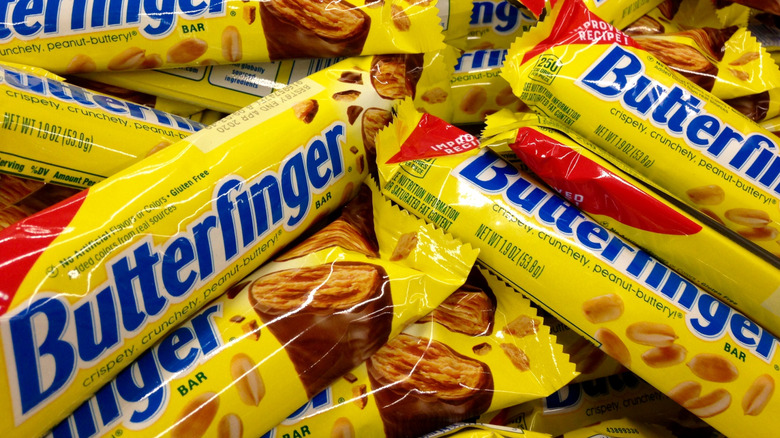If Butterfingers Aren't Chocolate, Then What The Heck Are They?
Butterfingers have been around since the 1920s, commanding both loyal followers and naysayers that claim it's one of the most overrated candies. Wherever you stand on the matter, there's something that not even its fiercest fans can deny: Butterfingers aren't chocolate. This isn't a strongly worded opinion meant to diminish the product's legitimacy. It's the legal truth.
You see, different chocolate types have varying standards that are set by the U.S. Food and Drug Administration. For instance, dark chocolate has to have at least 50% chocolate liquor (a combination of cocoa solids and cocoa butter) and sugar. Milk chocolate must contain at least 10% chocolate liquor, sugar, and milk. White chocolate is controversial because its lack of cocoa solids and minimum of 20% cocoa butter means it's not real chocolate.
So how do Butterfingers compare to these official standards? They have less than 2% cocoa, and no chocolate liquor. Even white chocolate has a stronger claim to the second part of its name than this popular yet deceptive product. In fact, the main ingredient in Butterfingers is corn syrup, followed by sugar, peanuts, vegetable oil, peanut flour, nonfat milk, cocoa, milk, salt, soy lecithin (a fatty substance), natural flavor, and annatto color (which is yellow-orange). And before 2018, the product had a new recipe but even less cacao, but continued to populate grocery store shelves next to real chocolate products for decades.
Given this, Butterfingers are most accurately described as candy bars.
Butterfinger's somewhat misleading marketing
If Butterfinger bars aren't chocolate, then how come most of us think they are? The answer is cleverly worded marketing that implies a strong presence of chocolate without explicitly saying it. If you visit Butterfinger's official site, you'll see that the product is described as a "crispety, crunchety, peanut buttery bar covered in a rich, chocolatey coating made with cocoa." Notice that the company states it's a peanut bar, and claims the coating is "chocolatey" rather than "chocolate." Because it legally can't call itself chocolate, Butterfinger has found a way to make people connect it with chocolate bars without actually claiming itself as one.
The website also makes a show of the two ingredients that it wants people to know about: peanuts and cocoa. It boasts about how it gets its peanuts from the United States (which is pretty cool), and about using ethically-sourced cacao (also cool). But what about corn syrup, the product's main ingredient? Zilch.
You'll only see it mentioned in the ingredient list, which is hidden from view unless you click on the "All Ingredients" button. Again, emphasizing two ingredients while leaving the others out is well-thought out but misleading marketing. Butterfinger is basically a candy bar that's scammed its way into getting invited to an exclusive chocolate bars-only party — and then allowed to stay because everyone is used to it.
If you love Butterfingers, go ahead and keep enjoying them! Just don't reach for them when you're craving chocolate.

